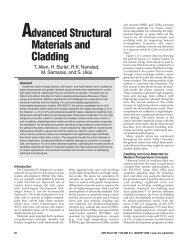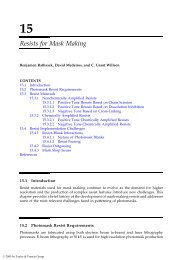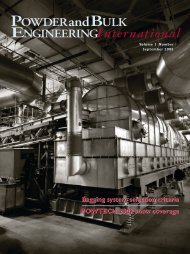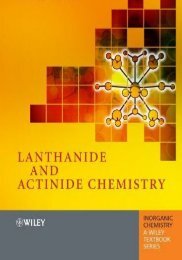Modeling of Biogas Reactors
Modeling of Biogas Reactors
Modeling of Biogas Reactors
Create successful ePaper yourself
Turn your PDF publications into a flip-book with our unique Google optimized e-Paper software.
192 6 <strong>Modeling</strong> <strong>of</strong> <strong>Biogas</strong> <strong>Reactors</strong><br />
Fig. 6.30 Concentration <strong>of</strong> suspended solids as a function <strong>of</strong> reactor height in the 15 m 3 pilot<br />
scale BTR. V · feed = 315 L h –1 ; total gas production <strong>of</strong> the reactor 2.3 m 3 h –1 ; gas recirculated 1.8 m 3<br />
h –1 ; ÄTOC = 7.3 kg m –3 ; gas loading V gas, i <strong>of</strong> the connecting areas between the modules as indicated.<br />
6.5<br />
Mass Transport from the Liquid Phase to the Gas Phase<br />
As demonstrated in Section 6.3, it is necessary to have quantitative data for the concentrations<br />
<strong>of</strong> the product gases, like CO 2, NH 3, and H 2S in the fermentation broth,<br />
to calculate the pH value within the fermentation broth and get information on the<br />
kinetics <strong>of</strong> methane production. To calculate these concentrations it is necessary to<br />
have additional information about the transport <strong>of</strong> these gases from the liquid phase<br />
– where they are produced by the microorganisms – to the gas phase. Basic ideas <strong>of</strong><br />
this calculation will be discussed with the example <strong>of</strong> H 2S because <strong>of</strong> its strong influence<br />
on biogas production. Polomski (1998) performed experiments on the desorption<br />
<strong>of</strong> H 2S from the fermentation liquid broth in laboratory and pilot scale reactors.<br />
The experimental setup <strong>of</strong> the laboratory experiment is shown in Figure 6.31. The<br />
UASB reactor is supplied with wastewater at the bottom. A part <strong>of</strong> the generated biogas<br />
is withdrawn at the top <strong>of</strong> the reactor and recycled to the bottom where it is injected<br />
by means <strong>of</strong> a perforated tube. The recycled biogas is either recycled directly<br />
or over a H 2S adsorber. The H 2S concentration in the fermentation liquid and the<br />
partial presure <strong>of</strong> H 2S in the gas were measured by means <strong>of</strong> a silicon membrane<br />
probe and the mass spectrometer (see also Section 6.2.1).






